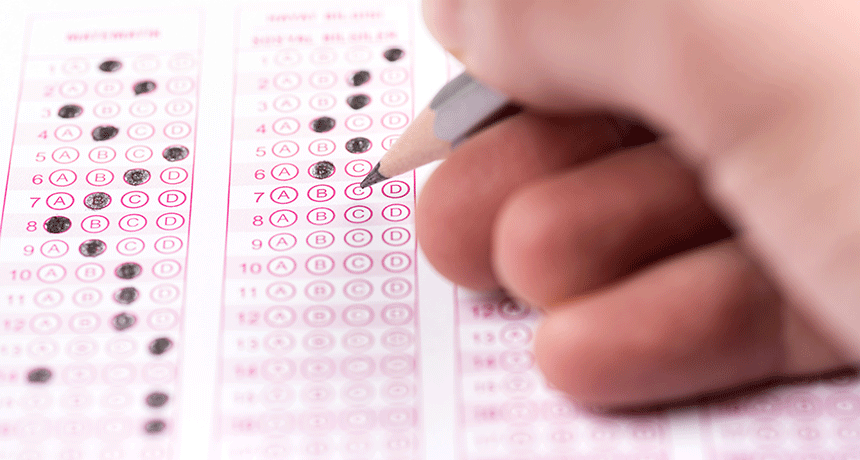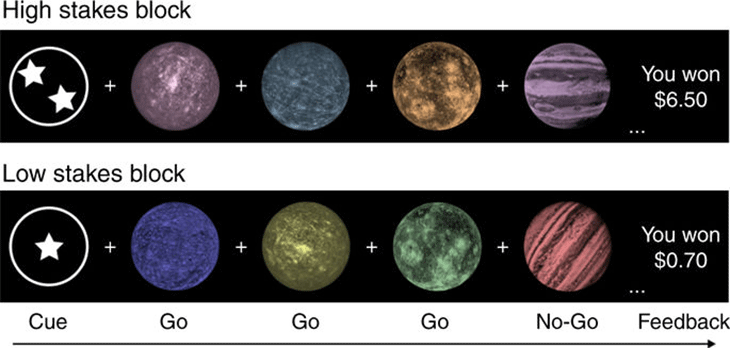Unlike adults, teens don’t perform better when the stakes are high
Adolescent brains might use their own strategy to get the job done

When tests are high stakes, teens don’t perform any better, a new study shows. But that’s not necessarily a bad thing.
turk_stock_photographer/istockphoto
It’s normal for adults to slack off a bit during the workday. If they have to join a meeting with the boss, though, they step up their game. Adults work harder when it matters more. Teens don’t. They perform the same whether the stakes are high or low. That might be because their brains’ circuitry is still making connections, a new study suggests.
People of all ages are used to working for rewards. You might practice an instrument to get better or train hard in preparation for a race. And you might expect people to work extra-hard when the stakes are especially high. This might include a recital or an important track meet.
“It’s like paying attention in class if you know there’s a pop quiz,” says Catherine Insel. “If it’s an ordinary day, you might not pay as much attention.” Insel is a psychologist, someone who studies the mind. She works at Harvard University in Cambridge, Mass.
Adults perform better when they have a lot to gain or lose. But scientists did not know whether teens did too. To find out, Insel recruited 88 people between the ages of 13 and 20. She had them try a game. The participants looked at pictures of planets on a computer screen. They had to click as fast as they could when they saw a planet with craters. They were not supposed to click if a planet had stripes. This kind of test is called a “go/no-go” task (as in “go” for the cratered planets; “no go” for the stripes).
Story continues below image.

But the game wasn’t the same every time. In some rounds, the participants could earn 20 cents for right answers but lose a dime for wrong ones. In other sessions, they’d get a dollar for right answers, and lose a half dollar for wrong ones. The dollar sessions were high stakes. Participants could win or lose a lot of money. The 20-cent sessions were low stakes. No matter how well or poorly they did, participants wouldn’t win or lose too much.
Players of all ages wanted to win the money, and cared more about bigger rewards than smaller ones.
As Insel expected, adults performed better when the stakes were high. But teens 13 to 18 played just as well whether they stood to win 20 cents or a dollar. Only 19- or 20-year olds stepped up their game for the higher stakes. So the younger teens were not just mini-adults in this situation, the researchers conclude.
Insel’s team published this work November 28, 2017, in Nature Communications.
Connecting brain bits
Brains change and mature during adolescence. And not all parts grow at the same rate. Insel was interested in two areas in particular. One is deep inside the brain and just above the ears. Called the ventral striatum (Stry-AY-tum), it helps the brain calculate rewards. Those rewards might be money. Sometimes they might be pizza or the ability to stay out late on a school night. The ventral striatum becomes mature during the teen years.
The brain’s prefrontal cortex takes longer to mature. This area — just behind the forehead — is important for planning and setting goals. It may not mature until early adulthood.
Nerve pathways — think of them as the brain’s “wiring” — connect the ventral striatum and prefrontal cortex. This lets the two regions communicate to make decisions. But because the prefrontal cortex matures later, the wiring between the two may not be complete until adulthood. And that may explain what the researchers saw in their go/no-go game results.
The teens and young adults weren’t playing this game at home. All were in a lab. And as they played, their brains were being scanned by a functional magnetic resonance imaging (fMRI) machine. It lets scientists watch blood flow.
Insel used the scans to monitor the two brain areas and connections between them. The idea was that more blood flows to parts of the brain that are busy than to ones that are at rest. So seeing higher blood flow in one area, therefore, might suggest it was more active as the teens were performing the game.
And how well players did indeed were linked to the connections in their brains. When the rewards were high, older players tried harder and performed better. At the same time, scans showed that their prefrontal cortex and ventral striatum were coordinating. But in younger teens, those two brain areas did not act in synchrony.
From planets to priorities
The study is “a really important step forward,” says Jennifer Silvers at the University of California, Los Angeles. She’s a developmental psychologist, someone who studies how the mind matures over time. The new finding, she says, “tells us how motivation might direct behavior” in teens.
Because teens don’t perform better when stakes are high, Silvers says, it could mean they aren’t as good as adults at prioritizing. For example, teens know it’s important to make friends and to do well in school. But they might not be able to decide which matters more, she explains.
That doesn’t mean teens are doing badly, Insel says. They just have a different strategy. If your goal is to get the most money on the planet-clicking task, she says, “you should just try as hard as you can on every single trial.” That’s what the teens did. If your goal is to be efficient, earning the most money with the least effort, you could do what adults do. They only try hard when the rewards are higher.
Anna van Duijvenvoorde is a developmental psychologist at Leiden University in the Netherlands. She sees another benefit to what the teens did. If they are doing their best all the time, she says, it might offer benefits as they try new things. “When you’re an adolescent,” she says, “maybe you haven’t set in stone what your interest or expertise will be.” Throwing themselves into a wide range of activities — even ones with small rewards — might help teens broaden their interests.
If it’s just a different strategy, why might the strategy change as we get older, van Duijvenvoorde wonders? Is the adult strategy somehow better? Does that suggest a better-connected brain is more efficient? And if so, why don’t those brain areas mature and connect sooner?
Examining older adults might help answer that. After all, the brain still isn’t finished developing at 20. It continues to mature for another five to 10 years! Studying adults who are 25, 30 or 35 might show how the brain changes the way it makes decisions. Younger and older brains may have even more hidden differences that help each make choices when there’s a lot on the line.







